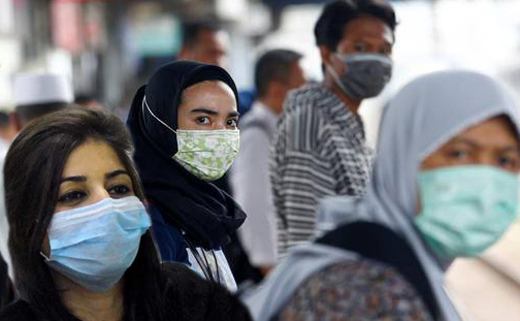WHO advise on medical mask and when not to wear a mask made of cloth
WHO advise on medical mask and when not to wear a mask made of cloth
mangaloretoday/ yahoo
New Delhi, June 08: The World Health Organisation has said that face masks made from cloth should not be used in places where social distancing norms are not followed.
In settings where physical distancing cannot be achieved and an increased risk of invention and or negative outcomes exist, then a medical mask should be preferred over a fabric one, the WHO said.

In an advisory, the WHO also said that anyone who is above the age of 60 or those with pre-existing health conditions including cardiovascular diseases, lung disease, diabetes, cancer of other underlying co-morbidities, must wear only a medical mask for their own protection.
While masks made from cloth can be used for activities such as public transport, their use should always be accompanied by frequent hand hygiene and physical distancing, the WHO also said.
WHO has recently changed its guidance on face masks, saying that people over 60 or with health issues should wear a medical-grade mask when they are out and cannot socially distance, while all others should wear a three-layer fabric mask.
The evidence on the protective value of single-use paper masks or reusable cloth coverings is less clear, but still suggests that face masks can contribute to reducing transmission of Covid-19. Analysis by the Royal Society said this included homemade cloth face masks.
Masks, eye protection key to stopping spread of COVID-19 says study
Wearing face masks, eye protection and maintaining two metres distance from others are the most effective ways to stop the spread of COVID-19, according to a study.
However, none of these interventions, even when properly used and combined offer complete protection from the infection. Other protective measures such as hand hygiene are needed to reduce the spread of the disease, according to a review of 172 studies from 16 countries published in the highly cited journal, The Lancet says.
The study found that the risk of the infection was 2.6 per cent when people stand more than a metre away from the infected people, against 12.8 per cent if they were within a metre. The analysis further said that masks and protective eye coverings also add protective benefits, through the evidence for that was less clear cut.
- Fog disrupts air travel across North India; over 105 flights cancelled in Delhi
- Bengaluru woman falls escaping hotel via drain pipe after cops bust party
- Senior Congress leader and Former Minister Shamanur Shivashankarappa dies at 94
- Congress Rallies at Ramlila Maidan Alleging ‘Vote Theft’; BJP Hits Back
- At Least 12 Killed in Shooting at Sydney’s Bondi Beach; Incident Declared Terror Attack
- Messi’s GOAT Tour Draws Massive Crowds, Mixed Reactions Across Indian Cities
- India Warns of Countermeasures After Mexico Hikes Tariffs on Select Imports
- Ex-Air Force officer arrested in Assam on charges of spying for Pakistan
- 2001 Parliament attack anniversary: PM Modi, Rahul Gandhi pay tribute to fallen heroes
- Lionel Messi’s blink and Miss Kolkata event angers fans, bottles thrown
- 3 US lawmakers move resolution to end President Trump’s 50% tariffs on India
- Bengaluru man electrocuted while trying to save pet parrot worth 2.5 lakhs
- Mangaluru: Scooter owner fined Rs 25,000 for allowing minor to ride, cusing accident
- Tourist bus en route to Kerala catches fire on road in Kodagu
- Mangaluru: Three arrested for supplying MDMA from Bengaluru to Mangaluru, 90 grams seized
- One Killed, Two Seriously Injured in KSRTC Bus–Omni Car Collision Near Vitla
- Two Arrested in Mangaluru for Sharing Sword-Dance Video on Social Media
- Feast of Events Planned at Coastal Beaches to Boost Tourism During Karavali Utsava
- Air India Express to Resume Mangaluru–Muscat Flights from March 2026
- Understanding All Religions Promotes Peace: Udupi SP
- India’s Role Crucial in Promoting Global Peace: Justice S Abdul Nazeer
- Karnataka NRIs Seek Dedicated Ministry, Submit Memorandum to CM
- Karnataka Govt to set up plastic park in Mangaluru: Minister M B Patil
- Souharda Christmas Utsav, Wine Carnival Inaugurated at Kadri Park
- Special train between Indore and Mangaluru to clear festive rush
- Mangaluru Student Goes Missing; Ullal Police Register Case
- APD Foundation Joins WHO Civil Society Commission
- Daiva’s prediction comes true: Janardhan Reddy walks free from jail
- Skills and Competencies Take Center Stage at MSN Dialogue Series
- Court remands Maoist Lakshmi to six-day police custody
- Sandhya Shenoy honored with Society for Materials Chemistry Medal-2024
- White Cornus Apartment in Mangaluru
- City girl wins first place in state-level spell bee competition
- Alleged ‘Love Jihad’ Case in Mangaluru: Woman left home voluntarily, says police
- Girl fatally struck by reckless two-wheeler near Belman
- New residential complex for the judges inaugurated in Mangaluru
- Absconding accused nabbed after 8 years
- Truck with cylinders turns turtle in Beltangady
- Bhoota Kola artist dies of cardiac arrest
- Development of the country should be our goal: Ganesh Karnik
- CITY INFORMATION
- TRAVEL
- TOURIST INFORMATION
- HEALTH CARE
- MISCELLANEOUS




 Write Comment
Write Comment E-Mail
E-Mail Facebook
Facebook Twitter
Twitter  Print
Print 

